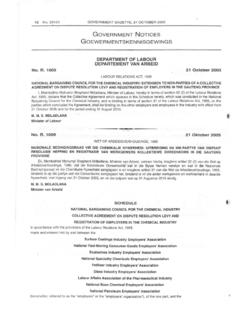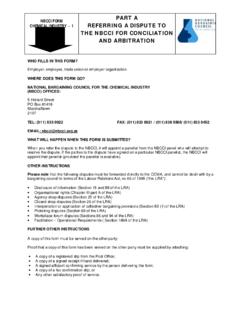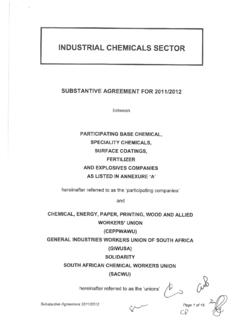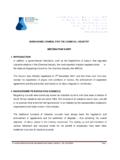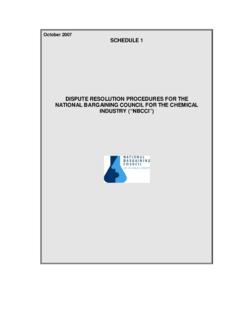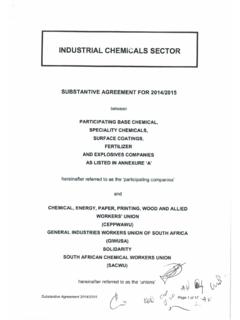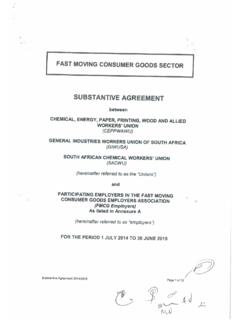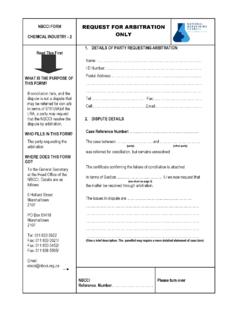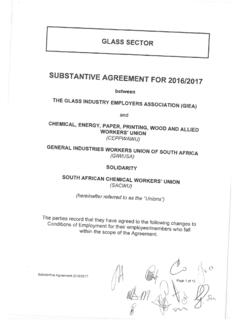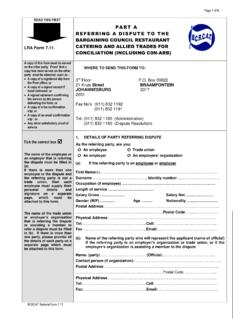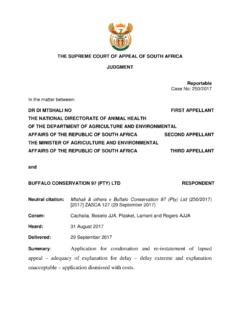Transcription of KZNCHEM12-13,14 Condonation Ruling - NBCCI
1 KZNCHEM12-13/14 Draft Condonation Ruling NKOSINDIPHILE S NTULI (Applicant) And CLARIANT SOUTHERN AFRICA (PTY) LTD(Respondent) Applicant s representative:Applicant s address:Respondent s representative:Respondent address: Condonation Ruling Panelist: Grahame Procter Case Number: KZNCHEM12 Date of Ruling : 25 October In the DISPUTE between: CLARIANT SOUTHERN AFRICA (PTY) LTD Applicant s representative: Self Applicant s address: PO Box 2027 Richards Bay 3900 Tel: 083 345 2638 Respondent s representative: Ms ME Louw Respondent address: PO Box 1042 Richards Bay 3900 Tel: 035 797 2200 Fax: 086 513 7762 Page 1 of 6 Condonation Ruling Grahame Procter KZNCHEM12-13/14 2013 KZNCHEM12-13/14 Draft Condonation Ruling Page 2 of 6 DETAILS OF HEARING AND REPRESENTATION 1.
2 This is a Ruling in respect of a referral and Condonation application submitted to the National Bargaining Council for the Chemical Industry (hereinafter referred to as the Council). The application was decided on papers. 2. The employee party, Mr Nkosindiphile S Ntuli (hereinafter referred to as the Applicant), represented himself. The employer party, Clariant Southern Africa (Pty) Ltd(hereinafter referred to as the Respondent), was represented by Ms Magdalena Louw, the Respondent s Compliance Officer and Acting Human Resources Manager. 3. Evidence considered was in the form of sworn affidavits submitted by the parties. ISSUE TO BE DECIDED 4.
3 I am required to decide whether the Applicant has shown good cause for the late referral of his unfair dismissal dispute and whether to grant or refuse Condonation accordingly. BACKGROUND TO THE ISSUE 5. The Applicant alleged he was dismissed on 30 September 2012. It appears he referred an unfair dismissal dispute, together with an application for Condonation of late referral, on 30 September Respondent filed its opposing affidavit within the prescribed time limit. SURVEY OF EVIDENCE AND ARGUMENT 6. Although I have considered all the submissions presented to me, section 138(7) of the Act requires me to provide brief reasons only with my Ruling . I shall thus only refer to the submissions and argument that I regard is necessary to support my findings and the determination whether to condone the late referral.
4 KZNCHEM12-13/14 Draft Condonation Ruling Page 3 of 6 Submissions by the Applicant 7. The Applicant submitted that his union failed to deal with his matter and he thereafter forwarded a message directly to the Production Manager. On 13 March 2013 he was stopped by the Respondent s lawyers who accused him of illegal and unlawful conduct. 8. According to the Applicant, he approached the CCMA on 3 September 2013, who assisted him with his referral. He was not informed that he was required to complete a sworn affidavit in support of his Condonation application. 9. The Applicant claimed that he did not sign a fixed term contract of employment and that the signature on the contract submitted by the Respondent was false and not his own.
5 He stated he was now unemployed with no income. Submissions by the Respondent 10. The Respondent submitted that the Applicant did not submit a proper application for Condonation as it was not supported by a sworn affidavit. The Respondent claimed the application was also not signed by the Applicant. 11. According to the Respondent, the Applicant s referral was 334 days late and was an excessive delay. The Applicant could have approached the CCMA at any point and he failed to explain the full period of lateness. 12. The Respondent stated the Applicant was employed on a fixed term contract from 1 October 2011 to 30 September 2013 and the Applicant could not have had an expectation of permanent employment.
6 13. The Respondent claimed that, in March 2013, the Applicant sent intimidating and threatening messages to certain of its employees. The Respondent s attorneys sent the Applicant a letter requesting him to cease his conduct. The Respondent only heard from the Applicant again when it received his referral on 30 August 2013. 14. The Respondent submitted it would be prejudiced as it would be difficult for its witnesses to recollect details of events and it would suffer unnecessary costs. KZNCHEM12-13/14 Draft Condonation Ruling Page 4 of 6 ANALYSIS OF EVIDENCE AND ARGUMENT 15. The Labour Relations Act has created time limits in which an Applicant must refer a dispute to the Council for conciliation and arbitration.
7 Section 191(1)(b)(i) requires a referral to be made within 30 days of the date of a dismissal. 16. The Act nevertheless makes provision for late referrals by stating further in subsection (2): If the employee shows good cause at any time, the council or the Commission may permit the employee to refer the dispute after the relevant time in subsection (1) has expired . 17. The Council will not have jurisdiction to deal with the dispute outside the time limit unless the Applicant applies for Condonation . In terms of Rule 9(3) of the Council Rules (the Rules), an application must set out the grounds for seeking Condonation and must include details of the following: (a) the degree of lateness; (b) the reasons for the lateness; (c) the referring party s prospects of succeeding with the referral and of obtaining the relief sought against the other party; (d) any prejudice to the other party; and (e) any other relevant factors.
8 18. Case law suggests these factors are interrelated and I will now consider all of them based on the submissions of the Applicant. Degree of lateness 19. The Applicant s contract of employment terminated on 30 September 2012, and his referral was required to be made within 30 days thereafter. In other words, by 30 October 2012. The Applicant s Condonation application, together with supporting sworn affidavits appears to have been received by the Council on 30 September 2013. This is evidenced by the council s date stamp on the second affidavit. The Applicant s referral was KZNCHEM12-13/14 Draft Condonation Ruling Page 5 of 6 therefore 334 days outside the prescribed time limit.
9 In my view, the degree of lateness is extremely excessive. Reason for lateness 20. The Applicant has placed the blame for his late referral on his trade union, but has failed to provide any further evidence to support this claim. Notwithstanding this, case law suggests an employee cannot always simply rely on the tardiness or negligence of his representative to justify the delay in referring his dispute (see Xayiya v African National Congress [2000] 4 BLLR 477 (LC); Parker v V3 Consulting Engineers (Pty) Ltd [2000] 21 ILJ 1192 (LC) and Kolobe v Proxenos [2000] 21 ILJ 1130 (LC). 21. In order for the Applicant s explanation to be considered reasonable, he also needs to show that he actively followed his case.)
10 The Applicant has provided no evidence to show that he pursued his dispute over the period of a full year and he has thus not provided an acceptable reason for the delay. Prospects of success on the merits of the case 22. According to the Applicant, the signature on the fixed term contract was not his and had been forged. It is not necessary for the Applicant to prove he will certainly succeed with his dispute and, for this reason, it is not necessary for me to consider the merits in detail. If the Applicant can prove,at arbitration, that the signature was indeed forged, it appears he may have some prospects of succeeding with his dispute. Any prejudice to the other party 23.
